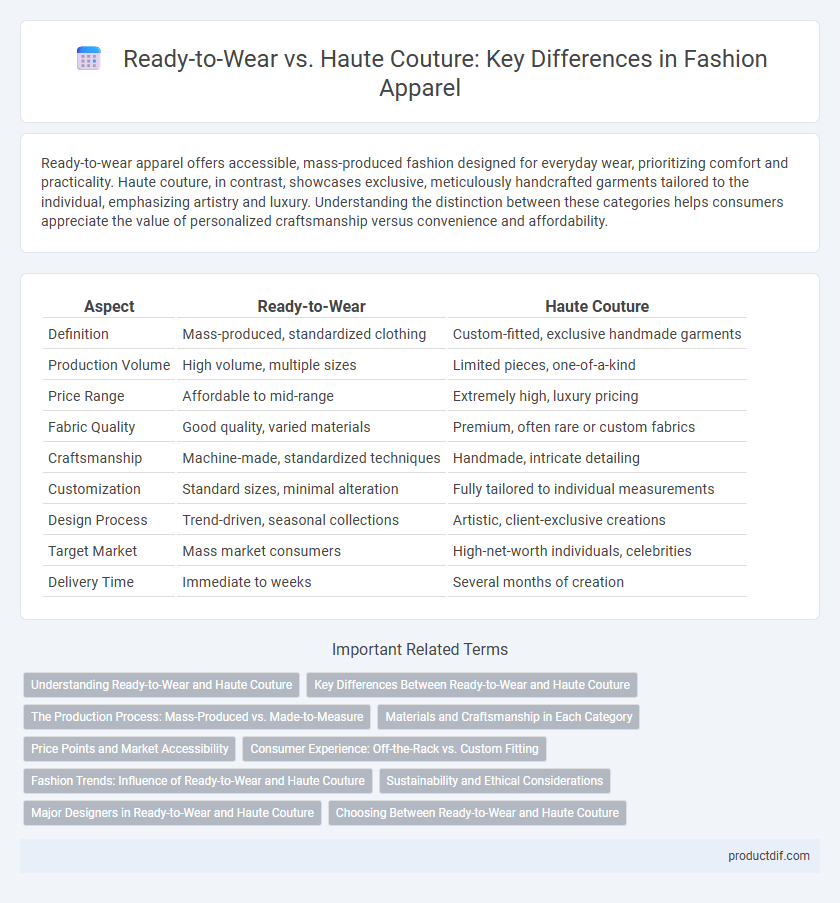Ready-to-wear apparel offers accessible, mass-produced fashion designed for everyday wear, prioritizing comfort and practicality. Haute couture, in contrast, showcases exclusive, meticulously handcrafted garments tailored to the individual, emphasizing artistry and luxury. Understanding the distinction between these categories helps consumers appreciate the value of personalized craftsmanship versus convenience and affordability.
Table of Comparison
| Aspect | Ready-to-Wear | Haute Couture |
|---|---|---|
| Definition | Mass-produced, standardized clothing | Custom-fitted, exclusive handmade garments |
| Production Volume | High volume, multiple sizes | Limited pieces, one-of-a-kind |
| Price Range | Affordable to mid-range | Extremely high, luxury pricing |
| Fabric Quality | Good quality, varied materials | Premium, often rare or custom fabrics |
| Craftsmanship | Machine-made, standardized techniques | Handmade, intricate detailing |
| Customization | Standard sizes, minimal alteration | Fully tailored to individual measurements |
| Design Process | Trend-driven, seasonal collections | Artistic, client-exclusive creations |
| Target Market | Mass market consumers | High-net-worth individuals, celebrities |
| Delivery Time | Immediate to weeks | Several months of creation |
Understanding Ready-to-Wear and Haute Couture
Ready-to-wear (pret-a-porter) apparel consists of machine-made, standardized clothing produced in large quantities and available off-the-rack, offering affordability and accessibility. Haute couture refers to custom-fitted, hand-crafted garments created by luxury fashion houses, emphasizing exclusivity, intricate detailing, and premium materials. Understanding the distinction between these categories highlights the contrast in craftsmanship, production scale, and consumer experience within the fashion industry.
Key Differences Between Ready-to-Wear and Haute Couture
Ready-to-Wear (pret-a-porter) offers mass-produced, standardized apparel designed for immediate purchase and wear, featuring accessibility and affordability as core attributes. Haute Couture garments are custom-made, meticulously handcrafted pieces tailored to individual clients, emphasizing exclusive fabrics, intricate detailing, and superior craftsmanship. The key differences lie in production scale, pricing, exclusivity, and personalization, with haute couture representing luxury fashion artistry and ready-to-wear catering to broader market availability.
The Production Process: Mass-Produced vs. Made-to-Measure
Ready-to-wear apparel involves mass-produced garments manufactured in standard sizes for broad consumer distribution, ensuring efficiency and scalability in production. In contrast, haute couture pieces are meticulously crafted using made-to-measure techniques, tailored specifically to an individual client's measurements and preferences. This bespoke approach requires extensive handwork, intricate detailing, and multiple fittings, resulting in exclusive, high-quality garments.
Materials and Craftsmanship in Each Category
Ready-to-wear apparel utilizes mass-produced fabrics like cotton, polyester, and blends, emphasizing efficiency and affordability while maintaining consistent quality standards. Haute couture relies on luxurious, rare materials such as silk, cashmere, and hand-embroidered embellishments, crafted meticulously by expert artisans through techniques like hand stitching and intricate beadwork. The craftsmanship in haute couture showcases exceptional attention to detail and customization, contrasting with the standardized production methods characteristic of ready-to-wear collections.
Price Points and Market Accessibility
Ready-to-wear garments offer more affordable price points, typically ranging from $200 to $2,000, targeting a broader market with mass production and widespread availability. Haute couture pieces command significantly higher prices, often exceeding $20,000 due to their handcrafted quality, exclusive materials, and limited production intended for affluent clients. Market accessibility for ready-to-wear is extensive, sold in retail stores and online, while haute couture remains niche, available primarily through exclusive fashion houses and private appointments.
Consumer Experience: Off-the-Rack vs. Custom Fitting
Ready-to-wear apparel offers consumers the convenience of immediate purchase with standardized sizing, catering to those seeking quick and accessible fashion solutions. Haute couture provides a personalized consumer experience through meticulous custom fittings, ensuring garments are tailored precisely to individual measurements and style preferences. This contrast highlights the trade-off between convenience and exclusivity, influencing consumer choices based on their priorities for fit, uniqueness, and time investment.
Fashion Trends: Influence of Ready-to-Wear and Haute Couture
Ready-to-wear collections drive mainstream fashion trends with accessible designs that quickly reach a global market, shaping seasonal styles and consumer preferences. Haute couture influences fashion by setting innovative, avant-garde standards that inspire ready-to-wear designers and elevate luxury craftsmanship. Together, they create a dynamic interplay where ready-to-wear amplifies couture's creativity, making high fashion trends attainable and influential across diverse audiences.
Sustainability and Ethical Considerations
Ready-to-Wear apparel typically employs mass production techniques that prioritize efficiency but may contribute to greater textile waste and lower labor standards, raising sustainability concerns. Haute Couture emphasizes handmade, custom garments using high-quality, sustainable materials and ethical craftsmanship, often resulting in a smaller environmental footprint. Consumers increasingly favor ethically made haute couture due to its focus on reduced waste, fair labor practices, and durable design.
Major Designers in Ready-to-Wear and Haute Couture
Major designers in ready-to-wear, such as Marc Jacobs, Alexander Wang, and Stella McCartney, focus on producing accessible, trend-driven collections that balance style with practicality for a broad market. Haute couture icons like Chanel's Virginie Viard, Dior's Maria Grazia Chiuri, and Givenchy's Matthew Williams emphasize meticulous craftsmanship, exclusive materials, and custom tailoring, creating one-of-a-kind garments that epitomize luxury and artistic expression. The distinction between the two lies in scale and exclusivity, with ready-to-wear targeting mass appeal while haute couture remains a symbol of personalized opulence and innovation.
Choosing Between Ready-to-Wear and Haute Couture
Selecting between ready-to-wear and haute couture depends on priorities like budget, exclusivity, and occasion. Ready-to-wear offers accessible, trend-driven fashion with standardized sizing and quicker availability. Haute couture provides bespoke craftsmanship, personalized fit, and unique designs tailored for luxury clients seeking one-of-a-kind apparel.
Ready-to-Wear vs Haute Couture Infographic

 productdif.com
productdif.com